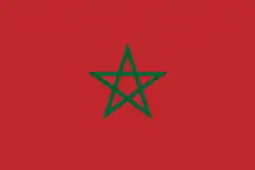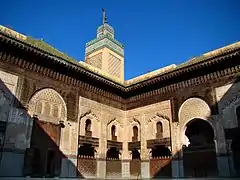Bab Doukkala Mosque
The Bab Doukkala Mosque (or Mosque of Bab Doukkala) is a major neighbourhood mosque (a Friday mosque) in Marrakesh, Morocco, dating from the 16th century. It is named after the nearby city gate, Bab Doukkala, in the western city walls. It is also known as the al-Hurra Mosque (or Mosque of the Free One, in reference to its founder, Massa'uda al-Wizkitiya).[1][2]
| Bab Doukkala Mosque | |
|---|---|
 | |
| Religion | |
| Affiliation | (Sunni) Islam |
| Year consecrated | 1570-71 CE (979 AH) |
| Status | Active |
| Location | |
| Location | Marrakesh, Morocco |
| Geographic coordinates | 31°37′52″N 7°59′44.7″W |
| Architecture | |
| Type | Mosque complex |
| Style | Saadian architecture, Moroccan, Islamic |
| Founder | Lalla Ma'suda bint Ahmad |
| Groundbreaking | 1557-58 CE (965 AH) |
| Completed | 1570-71 CE (979 AH) |
| Specifications | |
| Minaret(s) | 1 |
| Materials | brick, wood |
Historical background


It was commissioned by Lalla Mas'uda bint Ahmad, a daughter of Muhammad al-Sheikh (the founder of the Saadian Dynasty) and mother of Sultan Ahmad al-Mansur, during the Saadian Dynasty.[1] Construction of the mosque began in 1557-58 CE (965 AH) and probably finished around 1570-71 CE (979 AH), which would have been under the reign of Moulay Abdallah al-Ghalib.[1][3] Lalla Ma'suda's status as a powerful and "free" or independent woman may have given the mosque its alternate name of Jami' al-Hurra ("Mosque of Freedom").[1]
In 1557-58 CE the sultan had ordered that the Jewish population of the city relocate to an area closer to the Kasbah (royal citadel), resulting in the creation of a Jewish mellah which continued to exist into modern times. Construction of the new mellah was probably finished around 1562-63.[3] Meanwhile, the emptying of the old Jewish neighbourhoods had liberated a large amount of space within the city which was open to redevelopment. The Bab Doukkala Mosque, along with the Mouassine Mosque built around the same time, appears to have been part of a larger plan to build new "model" neighbourhoods in the area.[3] It was conceived as part of a coherent religious and civic complex which included, in addition to the mosque itself, a madrasa, library, hammam (public bathhouse) with latrines, and a public fountain for distributing water to the locals.[3][1] This type of architectural complex was unprecedented in Morocco, and may have been influenced by the tradition of building such complexes in Mamluk Egypt and in the Ottoman Empire.[4]
See also
References
| Wikimedia Commons has media related to Bab Doukkala mosque. |
- Salmon, Xavier (2016). Marrakech: Splendeurs saadiennes: 1550-1650. Paris: LienArt. ISBN 9782359061826.
- باحث, ذ أحمد متفكر / استاذ. "مسجد باب دكالة في مراكش ..التاريخ .. والمرافق". المراكشية : بوابة مراكش (in Arabic). Retrieved 2020-05-17.
- Wilbaux, Quentin (2001). La médina de Marrakech: Formation des espaces urbains d'une ancienne capitale du Maroc. Paris: L'Harmattan. ISBN 2747523888.
- Deverdun, Gaston (1959). Marrakech: Des origines à 1912. Rabat: Éditions Techniques Nord-Africaines.

